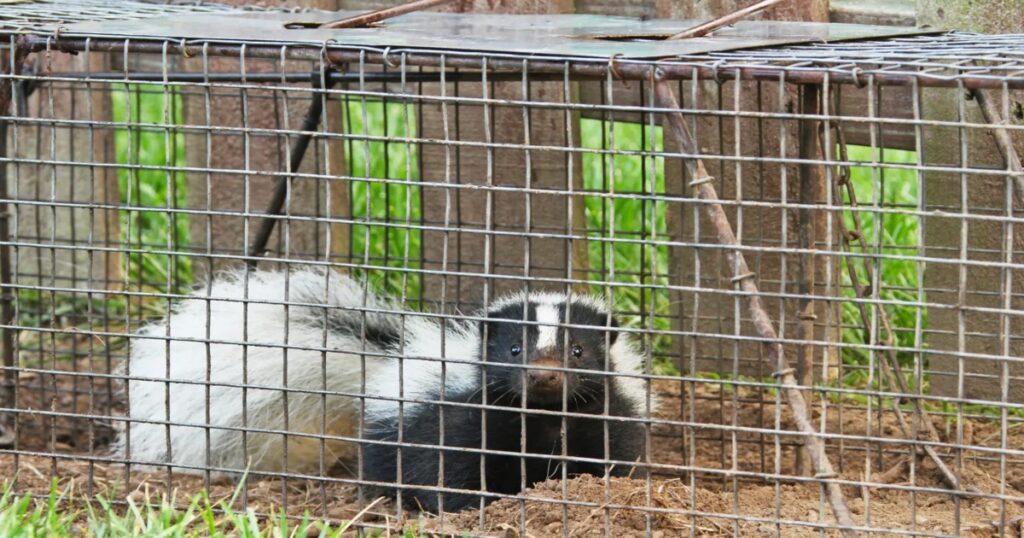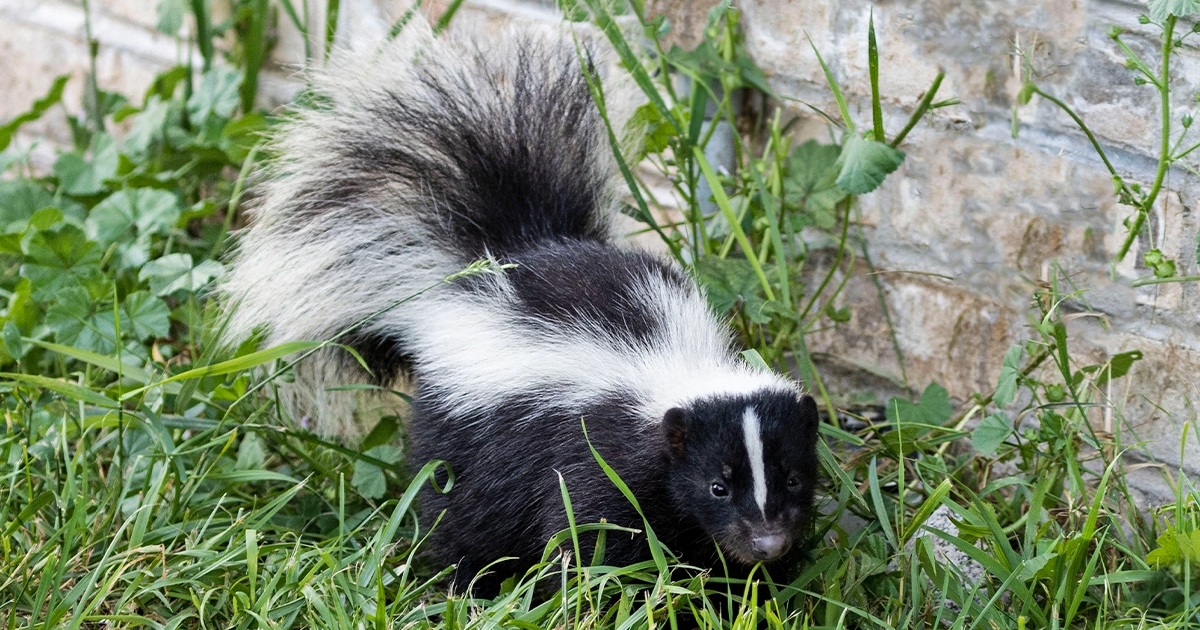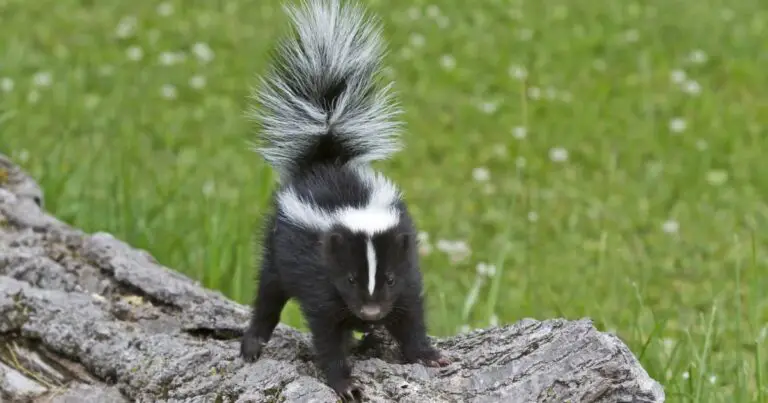How to Get Rid of Skunks: The Definitive Guide
Do you have a skunk problem? If so, you’re not alone. Skunks are notorious for causing problems in residential and commercial areas. They can damage property, spread disease, and cause a lot of noise.
In this blog post, we will provide you with a definitive guide on how to get rid of skunks. We will cover everything from identifying the signs of a skunk infestation to humanely trapping and removing them from your property. So read on and learn how to take care of your skunk problem once and for all!
What Are Skunks?
Skunks are nocturnal, sociable creatures that are generally non-violent and mild mannered. Instead of your garden, they prefer to eat small animals and insects. However, they may visit gardens if corn or other crops are close to the ground.
There are four skunk species in the United States, including the striped skunk (Mephitis mephitis) and the spotted skunk (Spilogale putorius). The common striped skunk is an inhabitant of open woodlands and pastures.
Skunks are beneficial to have around since they dig up and consume the cutworm, Japanese beetle, hornworm, and other crop-destroying insect larvae. That being said, skunks are not only fond of insects; they will devour leaves, buds, grasses, grains, trash, any fruit or berries within reach, and even small prey.
Why and How Do Skunks Spray?
Skunks are famous for their skunk spray—you can smell an angry skunk from over a mile away. Furthermore, a skunk can “shoot” you from 10 to 12 feet, sideways, up, or down, with little apparent effort.
Two pouches are located under a skunk’s tail, each with a pair of ducts that are hidden while the skunk is at ease but spring into action when danger approaches. Their noxious liquid is a golden-yellow liquid comprised of the sulfide mercaptan. Each of the two pouches holds enough to spray six times.
After the supply is used up, it takes a week to replenish it. Skunks have become an object of dread for nearly all other animals, including almost everyone on earth.
When confronted by a predator, skunks will attempt to sidestep by ambling off. This means that if you encounter a skunk, simply turn around and you’ll be fine. If threatened, skunks will spin around, face their assailant, and stamp their front feet. Their first indication comes when they spin around and face their attacker.
When their tails, with the exception of the tips, are hoisted, the second signal is given. The skunk assumes a U-shaped posture, with its snout and rear directed toward the target, and shoots a stream of spray.
Signs That You May Have Skunks On Your Property
Holes in and around your yard or along the boundaries of your home are one of the first indicators that skunks are present. Skunks like to dig for insects, which are one of their favorite meals. If you’re wondering how to get rid of skunks eating grubs, you should start at the source. Use nematodes to destroy the grubs.
It’s difficult to tell whether there are skunks or raccoons in your yard since both species like to dig shallow holes in search of grubs.
Skunk Feces
Skunk feces might or may not be present in your yard. It’s usually about an inch long and contains insect remains. If you do discover skunk dung, clean it up right away and wash your hands thoroughly. Skunk droppings can contain the rabies virus and other diseases, which can be harmful to humans and pets.
Tracks
If you’re still not sure whether you have skunks on your property, look for tracks. Skunk tracks look similar to those of a cat or small dog. You can find them in soft dirt or mud near areas where skunks are active.
Skunk Odor
One of the most obvious signs that you have skunks around is the unmistakable odor of skunk spray. If you catch a whiff of this foul-smelling substance, it’s a good indication that skunks are nearby. It smells so badly because of the mixture of chemicals containing sulfur, called thiols.
When a skunk feels threatened or intimidated, they’ll spray the area as a form of defense. Though they have poor eyesight, it’s not so bad that they’re not able to aim. Predators, pets, or really anything that spooks them may cause them to lift their tail and let out this nauseating spray.
What Attracts Skunks?
Removing attractants in your yard is the most effective way to keep skunks from returning. Here are some of the most common attractants:
- Trash: Secure your trash cans with lids and keep them away from the perimeter of your property.
- Food Sources: If you have a bird feeder, make sure it’s inaccessible to skunks and other animals. Clean up any spilled bird seed, as this will attract skunks. Same goes for pet food if you have any outdoor pets or animals.
- Water Sources: Skunks need water to survive, so eliminating sources of standing water on your property is key. Check for clogged gutters, leaky hoses, and pet bowls left outside overnight.
- Grubs & Insects: Earthworms act as beneficial soil additives for gardeners, so you shouldn’t kill them. However, if you want to avoid attracting skunks to your yard, you might want to get rid of grubs and other insects.
- Garden Plants & Vegetables: Skunks are omnivores that eat a variety of foods, including nuts, veggies, and fruits. If you have a garden and discover it has been disturbed, it’s possible that some of it has been eaten by skunks.
- Shelter: Skunks are constantly on the lookout for a safe place to sleep, especially if a mother is about to give birth to a litter of kits. If you notice any openings near your deck or detect the faint scent of skunk spray, it’s possible that a skunk has set up residence on your property.
- Chickens & Eggs: Chickens may be attracting skunks to your home. And, believe it or not, skunks can wipe out an entire flock of chickens and their eggs.
As you can see, getting rid of skunks can be a challenge. But with these tips, you’ll be able to keep them off your property for good!
How To Get Rid of Skunks In Your Yard
Getting rid of skunks in your yard is a simple process, if you know where to start. The secret is to figure out what’s attracting them to your property and which deterrents and repellents are most effective for you.
- Step 1: Eliminate possible attractants
- Step 2: Use skunk deterrents and repellents
- Step 3: Check to see whether the skunks have left your property
- Step 4: If the skunks continue to remain, apply new repellents and deterrents in order to drive them away
- Step 5: Set catch and release traps
If you are not able to successfully get rid of skunks on your own using the methods above, it might be time to contact a professional.
How To Trap Skunks

The first step is to choose a skunk trap. A live skunk trap should be big enough for them to move about freely, yet small enough that their tail cannot reach high up to spray. If their tail can’t lift all the way, skunks are considerably less likely to spray you!
What Bait To Use For Skunks
It’s crucial to use the proper bait when attempting to capture a skunk. Here are some good choices:
- Canned fish
- Cat food
- Peanut butter
- Insect larvae
- Chicken
Because skunks have such a keen sense of smell, the more odiferous the food, the better!
How To Set Up The Trap
Set the skunk trap in or near to their den, or anyplace where you know the skunks frequent. This should be done in the evening. Then, check the trap early each morning until you’re successful. If you do not catch the skunk in the first night, try switching up the attractant that you use.
Where and How To Release Skunks
Approach the trap with care and patience once you’ve captured the skunk. Bring a towel or blanket to cover the top of the cage to prevent spraying and calm the animal down.
The last thing you want to do is bring a skunk into your home. However, like with most wild animal releases, you don’t want to transport them too far away from your property. If the skunk is unable to return to the region where they are comfortable, they will starve and die.
You must also consider the possibility that the skunk has offspring to care for. If you’re unsure, call your local animal control. They will assist you in determining the greatest course of action.
The key to catching and releasing a skunk is to make sure your yard is secure once you’ve released it several miles away. You don’t want them to fall back into their old habits if they return to your home. Install stronger fences and use repellents or deterrents to keep them out.
How to Keep Skunks Away
- Skunks dislike the scent of this mixture, which is made with castor oil and dish-washing detergent. The odor is repulsive to skunks. When the skunk is away foraging, spread the solution near their den at night.
- A light is perhaps the most effective skunk repellent. Skunks are nocturnal, and their eyes are extremely sensitive to light. Skunks will avoid areas illuminated by a bright light or a motion detector floodlight.
- Skunks, like other animals, despise the odor of citrus fruits. As a natural skunk repellent, scatter orange or lemon peel throughout the garden.
- A skunk will not approach a yard that contains predator urine (dogs, coyotes). These are available in gardening stores. (Note: To ensure that the animals are treated humanely and the brand adheres to state and federal laws, use a reputable source for predator urine.)
- If skunks are located in a smaller garden area, place bars of strong-smelling soap or a room deodorizer near your plants. Ironically, skunks despise strong aromas.
If nothing works, there are humane ways for professionals to trap raccoons and skunks and transport them elsewhere. Often, skunk removal by trapping is the only answer, and there just isn’t a lot you can do if it is a skunk. However, be aware that many species of wildlife do not survive when placed in a new territory, and it may not even be legal to trap and relocate wild animals in your area.
Home Repellents For Skunks
Many individuals are unsure about what home treatment will eliminate skunks. Some of these DIY repellents may be effective. However, if the skunks have adjusted well to their surroundings, it may not be as successful.
Don’t forget that homemade repellents require frequent applications, as the components such as wind and rain rapidly wear down on scent and taste.
Homemade Skunk Repellent Spray
- Bring a two quartz of water to a boil, add one yellow onion, a jalapeno pepper, and some cayenne, then drain.
- Spray your repellent around the areas where you don’t want the skunk to return.
You may even soak old rags in the solution (bleach works as well!) and use a straightened coat hanger to poke them into the skunk’s hole. This method is particularly beneficial if they’re nesting in the crawl space beneath the home or other difficult-to-reach locations.
Used kitty litter (although quite disgusting) can also be used as a perimeter treatment around your yard, garden, or chicken coop. You can also find many skunk repellents at most gardening and big-box stores.
DO NOT use chocolate as a skunk repellent. Chocolate contains a toxic chemical called theobromine that is harmful to skunks and many other species. Moth balls are also frequently suggested, but because they’re highly poisonous, they provide little impact.




One Comment